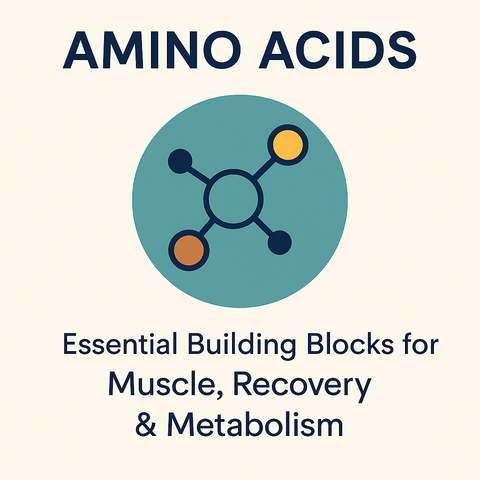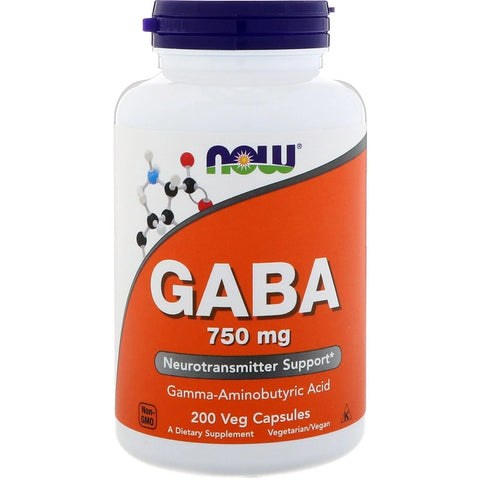
Amino Acids: Essential Building Blocks for Muscle, Recovery & Metabolism
1. Introduction to Amino Acids
Amino acids are the building blocks of proteins and are vital to nearly every biological process in the human body. As organic compounds composed of nitrogen, carbon, hydrogen, and oxygen, amino acids play crucial roles in metabolism, tissue repair, enzyme function, and overall cellular structure. They are classified into three main categories: essential, non-essential, and conditionally essential amino acids.
Proteins, composed of amino acid chains, contribute to the maintenance and growth of muscle mass, and support normal bone health. According to the European Food Safety Authority (EFSA), "protein contributes to a growth in muscle mass," and "protein contributes to the maintenance of normal bones." These statements underscore the importance of amino acids in supporting core structural and functional health aspects.
Out of the 20 standard amino acids found in human proteins, nine are considered “essential” because the body cannot synthesize them on its own and they must be obtained through dietary sources. These include histidine, isoleucine, leucine, lysine, methionine, phenylalanine, threonine, tryptophan, and valine. They are commonly found in foods high in protein such as meat, fish, dairy, eggs, and legumes, and are also available in concentrated forms as supplements.
Non-essential amino acids, such as alanine, asparagine, and glutamic acid, can be produced by the body. However, during times of physical stress, illness, or intense exercise, the demand for certain amino acids—like glutamine or arginine—can exceed the body's ability to produce them. In such cases, these become “conditionally essential.”
Amino acid supplements have grown in popularity among athletes, fitness enthusiasts, and individuals with increased nutritional needs. They are available in various forms including powders, capsules, and tablets. These supplements are particularly valued for their role in muscle maintenance, especially during weight loss, aging, or recovery periods.
It’s important to recognize that amino acid intake must align with broader dietary and health needs. Excessive or unbalanced consumption may not offer added benefits and could strain metabolic pathways. Products marketed in the EU must comply with EFSA regulations, ensuring that any health claims made are backed by scientific evidence and relevant to the general population.
Moreover, some vitamins and nutrients work synergistically with amino acids. For example, folate contributes to normal amino acid synthesis—an EFSA-approved claim highlighting the interplay between vitamins and protein metabolism.
In summary, amino acids are foundational to life, health, and performance. They are essential nutrients that support protein synthesis, muscular structure, metabolic function, and overall well-being. As we explore further in this guide, understanding each amino acid’s role, source, and benefit can empower individuals to make informed choices in their nutrition strategy.
2. Essential vs. Non-Essential Amino Acids
Amino acids are vital components of protein synthesis and play integral roles in virtually every physiological process. They are categorized based on the body’s ability to produce them—either internally or requiring external dietary sources. This categorization gives us two major types: essential amino acids and non-essential amino acids.
What Are Essential Amino Acids?
Essential amino acids (EAAs) are those that the human body cannot synthesize on its own in sufficient quantities. Therefore, they must be obtained from the diet. These include:
-
Histidine
-
Isoleucine
-
Leucine
-
Lysine
-
Methionine
-
Phenylalanine
-
Threonine
-
Tryptophan
-
Valine
These amino acids are found in high-protein foods like meat, fish, eggs, dairy, soy, and legumes. Supplements containing essential amino acids are popular in sports nutrition, especially for their support in muscle maintenance and repair.
The EFSA recognizes the contribution of protein to health through several claims:
-
"Protein contributes to the growth of muscle mass."
-
"Protein contributes to the maintenance of muscle mass."
-
"Protein contributes to the maintenance of normal bones."
These claims are particularly relevant for essential amino acids, since they are directly responsible for enabling the body to synthesize complete proteins—particularly in scenarios where muscle mass must be preserved or developed.
Each essential amino acid has a specific role:
-
Leucine plays a key role in stimulating muscle protein synthesis.
-
Lysine contributes to normal protein metabolism and is important for tissue growth and repair.
-
Tryptophan is a precursor to serotonin, although health claims related to mood regulation require further evidence for EFSA endorsement.
-
Methionine contains sulfur and plays a role in methylation and detoxification pathways.
-
Phenylalanine is converted into tyrosine, which is a precursor for several neurotransmitters.
Branched-Chain Amino Acids (BCAAs)
Three essential amino acids—leucine, isoleucine, and valine—are categorized as Branched-Chain Amino Acids (BCAAs) due to their branched molecular structure. These are especially significant for athletes and active individuals.
BCAAs are metabolized primarily in the muscle, rather than the liver, which makes them more directly accessible for muscular energy and repair. They are often used during workouts or periods of muscle recovery. According to EFSA, protein intake supports muscle mass maintenance and growth, and BCAA supplementation is aligned with these benefits.
Although there are no standalone EFSA-authorized health claims for BCAAs specifically, their role in muscle protein synthesis ties directly into the broader approved protein-related claims.
What Are Non-Essential Amino Acids?
Non-essential amino acids are those that the body can synthesize on its own, using intermediates from metabolism or other amino acids as precursors. These include:
-
Alanine
-
Asparagine
-
Aspartic acid
-
Glutamic acid
-
Serine
Despite being "non-essential" in dietary terms, these amino acids still perform critical functions:
-
Glutamic acid acts as a neurotransmitter and is involved in brain function.
-
Aspartic acid supports the urea cycle and energy production.
-
Serine is necessary for synthesizing phospholipids in cell membranes.
While EFSA does not provide direct health claims for individual non-essential amino acids, they still contribute indirectly to broader physiological benefits through their roles in protein metabolism.
Conditionally Essential Amino Acids
A third group, often called conditionally essential amino acids, includes:
-
Arginine
-
Cysteine
-
Glutamine
-
Glycine
-
Proline
-
Tyrosine
These amino acids are normally synthesized by the body but may need to be supplemented under specific conditions such as illness, stress, rapid growth, or trauma. For example:
-
Glutamine demand increases during prolonged physical stress and is often supplemented by endurance athletes.
-
Arginine is involved in nitric oxide production and vascular health, though specific EFSA claims on these functions remain under review or not authorized.
Importance of Balanced Amino Acid Intake
While a balanced diet typically provides all necessary amino acids, supplementation may be beneficial for:
-
Vegetarians and vegans who may have limited sources of complete proteins.
-
Older adults experiencing sarcopenia (age-related muscle loss).
-
Individuals recovering from surgery or illness.
-
High-performance athletes under heavy training loads.
Amino acid supplements—especially those containing a full spectrum of essential amino acids or BCAAs—can support nutritional adequacy and enhance the benefits of physical activity and resistance training.
It’s essential to note that amino acids are best utilized when consumed as part of a diet that includes adequate calories, vitamins, and minerals. For instance, EFSA confirms that "folate contributes to normal amino acid synthesis," indicating the interconnectedness of nutrients in metabolic pathways.
3. Branched-Chain Amino Acids (BCAAs)
Branched-Chain Amino Acids (BCAAs) are a subgroup of essential amino acids known for their unique structure and their important role in muscle metabolism. They include:
-
Leucine
-
Isoleucine
-
Valine
These three amino acids are distinguished by their branched molecular structure, which allows them to be metabolized differently compared to other amino acids. Unlike most amino acids that are primarily broken down in the liver, BCAAs are predominantly metabolized in skeletal muscle. This property makes them especially important for individuals engaged in physical activity, as they can be rapidly used for energy and repair.
The Role of BCAAs in Protein Synthesis and Muscle Function
Leucine, isoleucine, and valine play a direct role in muscle protein synthesis. In fact, leucine is particularly known for its role in initiating the mTOR (mammalian target of rapamycin) pathway—a key signaling pathway that stimulates muscle growth and repair after physical exercise. This aligns with the EFSA-approved claim:
-
"Protein contributes to the growth and maintenance of muscle mass."
While EFSA does not provide individual claims for leucine, isoleucine, or valine, the link between BCAAs and protein’s approved functions underscores their significance in maintaining muscle tissue. Therefore, BCAAs contribute to the broader benefits associated with adequate protein intake.
BCAAs also support:
-
Muscle recovery: After intense physical activity, muscle fibers need repair. BCAAs provide the raw materials for that process.
-
Reduced muscle breakdown: By serving as an energy source during endurance and strength training, BCAAs may help preserve lean mass, especially in energy-deficient states.
Supplementation and Use Cases
BCAA supplements are typically used:
-
Before or during workouts to delay fatigue.
-
After exercise to support muscle recovery and protein synthesis.
-
During caloric restriction or fasting, to preserve lean muscle mass.
They are commonly available in powder form for mixing into drinks or in capsules. Athletes and active individuals often find them useful during prolonged endurance sessions or intense resistance training programs.
The standard ratio found in supplements is 2:1:1 for leucine:isoleucine:valine, which mimics the natural proportion found in muscle tissue and is considered effective for promoting anabolic processes.
BCAAs vs. Whole Protein Sources
While BCAAs offer concentrated delivery of three essential amino acids, they do not provide the full spectrum needed for complete protein synthesis. For this reason, BCAA supplements are often used in conjunction with whole protein sources, such as whey protein isolate or casein, which provide all nine essential amino acids.
It’s important to maintain a balanced amino acid intake to support the body's full range of protein synthesis needs. EFSA highlights this through its emphasis on total protein intake rather than isolated amino acids in its health claims. Nonetheless, BCAAs can serve as a rapid-access source of key building blocks, especially under metabolic stress.
Nutritional Synergy
For optimal effect, BCAAs can be taken alongside other nutrients:
-
Vitamin B6 supports protein metabolism (EFSA claim: "Vitamin B6 contributes to normal protein and glycogen metabolism").
-
Folate contributes to normal amino acid synthesis.
Combining BCAAs with carbohydrates post-workout may further enhance muscle recovery by stimulating insulin release and nutrient uptake into muscle tissue.
Safety and Regulation
BCAA supplements are generally recognized as safe when consumed at recommended doses. Products sold in the European Union must comply with EFSA standards, ensuring purity, accurate labeling, and adherence to approved health claims.
However, excessive intake of isolated amino acids may upset amino acid balance in the body and is not recommended without clear nutritional need or supervision. Moderation and appropriate dosing are key.
Conclusion
BCAAs—leucine, isoleucine, and valine—play a critical role in muscle metabolism, energy production, and post-exercise recovery. While EFSA does not authorize individual claims for each BCAA, the approved claim that "protein contributes to the maintenance and growth of muscle mass" encapsulates their contribution when taken as part of a protein-rich diet or supplementation plan.
For athletes, active individuals, and those aiming to preserve lean mass during dieting or aging, BCAAs offer a targeted way to support muscle performance and resilience.





